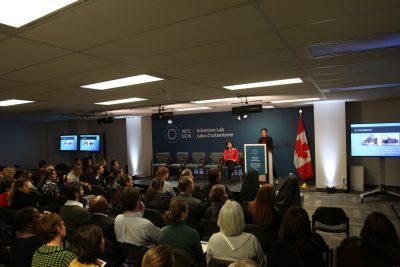Studying Living Heritage Through an Oral History Project
By Emilee Petrie

Before studying history at university, I might have thought of history as something that was studied solely through the analysis of textual and archeological sources. Before starting this practicum, I knew very little about modern monasteries and what I did know about monasteries came largely from studying Medieval history. I had, and still have, a lot to learn.
As part of the Practicum in History at Carleton University, I worked with the National Capital Commission (NCC) to learn about and preserve the history of a Gatineau monastery. The Congrégation des Soeurs-Servantes de Jesus-Marie is a contemplative and cloistered religious community. It was founded in the Outaouais region of Quebec in 1894. It was relocated to Hull in 1902, where it has been ever since. In 2017, the Congrégation sold its maison-mère (mother house) in Hull to the NCC. The Congrégation, the NCC, the Ville de Gatineau, the Réseau du patrimoine de Gatineau et l’Outaouais, the Société d’histoire de l’Outaouais, Marie Roy and I collaborated on an oral history project to preserve the history of the Soeurs-Servantes before they move to a building more suited to their smaller population and self-sufficient lifestyle. I was fortunate to be a collaborator in the early stages of this project when we interviewed twelve of the forty-two Soeurs-Servantes.
This oral history project made me reconsider what I thought I knew about monasteries. For example, most outside sources refer to the building in which the Soeurs-Servantes live as a convent. However, when speaking with the Mère-Servante of the Congrégation, I learned that they preferred to call it a monastery as the term more accurately describes their lifestyle and vows.
In just this way, this project gave the Soeurs-Servantes the opportunity to combat some stereotypes known and applied by most people. It also gave them to opportunity to decide what is important about their own culture and history, and to represent that history to a larger audience. Despite being cloistered, the Congrégation is not a static community displaced by time. With the integration of the internet and electronic devices into the Congrégation, the Soeurs-Servantes have greater access to the outside world, such as their own personal emails, and increased access to phones and information. One Soeur-Servante spoke about the importance of reading the news and knowing what goes on around the world so that they can include this information into their prayers. The Soeurs-Servantes are aware of the world and adapt with it.
One of the greatest benefits of oral history is that it allows for the self-determination of one’s own story. It allows for a greater understanding of a people’s history with the diminishment of an outside bias on that story. Oral history also diminishes the distance between a historical record and an audience. From oral history, we can get an understanding as to what a person thought or felt about an experience. We can learn things from oral history that we cannot learn elsewhere. I was fortunate to work on this project and to be inspired by the Soeurs-Servantes.
Learn more about the work that our students have undertaken as part of HIST 3807: Practicum in History here.